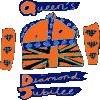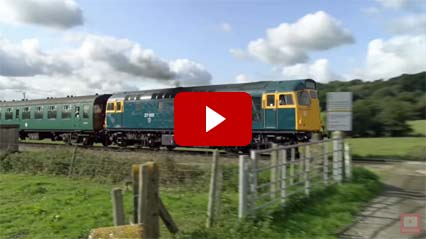This British diesel locomotive compilation features a variety of locomotive classes on both the mainline and preserved heritage lines. Many classes of diesel locomotives are featured including Class 20, Class 27, Class 31, Class 33 "Crompton", Class 37, Class 47, Class 55 "Deltic", Class 57, Class 56 "Grids", Class 66, and Class 67. Multiple filming locations were used across the national network plus a number of heritage railways including the Epping & Ongar Railway and the Spa Valley Railway. Compiled 12 Mar 2020.
List of BR Modern Traction Locomotive Classes
HST Information
Preserved Diesels
The 47's Brush Sulzer Type 4
Diesel & Electric Preservation Group
Progress Rail (Link fails 21 May 2022)
ScotRail Inter7City
East Midlands Railway (Link fails 23 Nov 2022)
Greater Anglia (error 503)
Heathrow Express (Link fails 4 Oct 2021)
Hull Trains
North South & Central Trains
ScotRail
Transport for Wales / Trafnidiaeth Cymru
West Midlands Railway (Link fails 23 Nov 2022)
British Rail Main Line Diesel Locomotives
Colin J. Marsden and Graham B. Fenn.1988OPC Railprint.Hardcover.40 pages, 20.8 x 30.6 cm, £19.99 (Amazon)The book includes full technical details, photographs, and 4mm to 1 foot scale drawings of every type and variant of diesel locomotive class on main line duties, with technical specifications in tabulated format, operational histories of each type, livery variations, detail modifications, insignia, sub-sector symbols, and nameplates.The Rise and Fall of British Railways Main Line Diesel Locomotives
John Vaughan.2011Haynes Publishing.Hardcover.224 pages, 21 x 26.9 cm, £28.45 (Amazon)In a feast of railway nostalgia, this gloriously illustrated book celebrates the history of British-built main line diesel locomotives constructed between 1947 and 1993. Written by a respected railway author, it features locomotives from the whole of mainland Britain, with particular emphasis on the years from 1968, when steam ended on British Railways, to the arrival of the new generation of North American diesels at the end of the 1990s. The authoritative text is supported by a wealth of photographs spanning the period 1948 to 2008, most of them published for the first time.British Diesel Locomotives
David Hucknall.2012The History Press.Hardcover.160 pages, 16.5 x 25.4 cm, £16.70 (Amazon)The rapid dieselization of Britain's railways meant that many designs of locomotives were introduced from various manufacturers. Some were highly successful and generated a very enthusiastic following that continues today. British Diesel Locomotives is a superb collection of black-and-white photographs, supported by David's usual meticulously researched and well-written captions, that portrays important locomotive classes. From the Deltics, Warships, and the Westerns to the Class 50s and 47s and even including the humble but essential multiple units, this book will remind readers of a fascinating evolutionary period for Britain's railways.Classic Diesels in Colour
Roger Siviter.2012The History Press.Hardcover.128 pages, 19 x 26.7 cm, £13.64 (Amazon)Over the past thirty years or so, many changes have taken place on Britain's railway system. None more so than in the 1980s and 1990s, with the withdrawal of many classes of diesel locomotives, thus cutting down greatly on the number of locomotive-hauled passenger trains. However, although classes such as Deltics, Class 40s, 45s, and 50s have long been withdrawn, many examples of these classes have been preserved, and over the last few years have been seen on the main lines in charge of special enthusiasts' trains. Coupled with the withdrawals of many classes of freight locomotive and the disappearance of much infrastructure, the changes become very noticeable. Roger Siviter's book sets out to show a great many of the now classic locomotives in their everyday work of yesteryear, but also some of the many specials they can be seen on today in this impressive collection of colour photography.British Diesel Locomotives of the 1950s and '60s
Greg Morse.2016Shire Publications.Paperback.64 pages, 14.9 x 21.1 cm, £7.99 (Amazon)After the Second World War, the drive for the modernization of Britain's railways ushered in a new breed of locomotive, the Diesel. Diesel-powered trains had been around for some time, but faced with a coal crisis and the Clean Air Act in the 1950s, it was seen as a part of the solution for British Rail. This beautifully illustrated book, written by an expert on rail history, charts the rise and decline of Britain's diesel-powered locomotives. It covers a period of great change and experimentation, where the iconic steam engines that had dominated for a century were replaced by a series of modern diesels including the ill-fated "Westerns" and the more successful "Deltics".British Rail Diesels: The Lives of the Early Diesels in Photographs
Mick Hymans.2016The History Press.Hardcover.160 pages, 15.2 x 22.9 cm, £20.00 (Amazon)I remember how excited I was when I saw my first diesel. I was waiting for the usual West Country Class to come through Hampden Park when a Class 33 arrived instead. It was the talk of all the trainspotters at the junior school. Author Mick Hymans excitement soon turned to resentment as diesels replaced his beloved steam engines. They became rarer and rarer until in 1968 they disappeared altogether. Today the diesel engine enjoys a vast following in its own right. Preserved railways now run diesel days, steam-free days, which prove to be some of the most popular events in their calendars. Covering the whole railway system from the north of Scotland and Wales right down to Cornwall, British Rail Diesels presents a wide collection of photographs illustrating a lost world of the nations railways.Locomotives 2020: Including Pool Codes and Locomotives Awaiting Disposal
Robert Pritchard.2019Platform 5 Publishing Ltd.Paperback.105 pages, 10.4 x 14.7 cm, £5.75 (Amazon)The complete guide to all locomotives which operate on National Rail and Eurotunnel. Details for every locomotive includes livery, owner, number carried, and allocation. Data is correct to October 2019.Inter-City 125 High Speed Train: Owners' Workshop Manual
Chris Martin.2019J.H. Haynes & Company Ltd.Hardcover.176 pages, 21.7 x 27.6 cm, £17.99 (Amazon)The Inter-City 125 was the brand name of British Rail's High Speed Train (HST) fleet, which was built from 1975 to 1982 and was introduced into service in 1976. The Inter-City 125 train is made up of two Class 43 power cars, one at each end of a set of carriages (the number of carriages varies by operator). The train operates at speeds of up to 125 mph in regular service, making it the fastest diesel-powered train in the world, a record it has held from its introduction to the present day. After four decades, most of the HST fleet is still in front-line service, with various UK train operators. This fascinating Inter-City 125 High Speed Train Owners' Workshop Manual looks at the evolution and anatomy of the Inter-City 125, along with details of the operation, servicing of the trains, views from drivers, and details of how the trains were modernized for the 21st century.Early and First Generation Green Diesels in Photographs
Brian J. Dickson.2020The History Press.Hardcover.128 pages, 19.6 x 26.4 cm, £16.00 (Amazon)The "Big Four" railways had experimented with diesel-powered shunting locomotives from 1933 with the Great Western Railway seeing the advantages of operating diesel-powered rail cars, and doing so successfully from the same date. The 1955 "Modernization Report" predicted the end of steam power and laid out the basis of the "Pilot Scheme" for the introduction of main line diesel locomotives to British Railways. A number of these hastily designed classes of locomotives were found wanting in terms of power and especially reliability, but pressure to forge ahead with their introduction meant that the numbers constructed were unrealistic, and in consequence, many had very short operating lives. Fortunately, the "Pilot Scheme" did bring forward some excellent reliable classes of locomotives that were produced in large numbers, with examples surviving into the modern railway operating companies and the preservation scene. Early and First Generation Green Diesels in Photographs brings together the work of four photographers Ron Buckley, Robert Butterfield, Andrew Forsyth, and Hugh Ramsay charting the development of diesels in their photographs from 1949 to 1966.

















